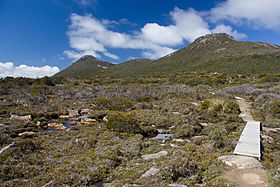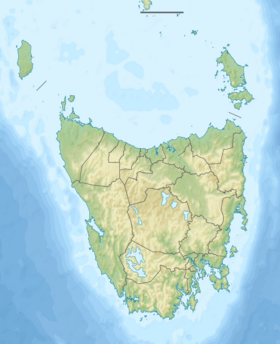Hartz Mountains (Tasmania) facts for kids
Quick facts for kids Hartz Mountains |
|
|---|---|

Hartz Mountain and Mount Snowy
|
|
| Highest point | |
| Elevation | 1,254 m (4,114 ft) AHD |
| Prominence | 838 m (2,749 ft) |
| Isolation | 16.16 km (10.04 mi) |
| Geography | |
| Location | Southern Tasmania, Australia |
| Parent range | Hartz Range |
The Hartz Mountains are mountains with twin peaks located in southern Tasmania, Australia. The mountains are situated 55 kilometres (34 mi) south west of Hobart, via Geeveston, and are part of the Hartz Mountains National Park. The Hartz Mountains area experiences typical south-west weather conditions. In all seasons there can be snow, chilling rains, low temperatures, strong winds, upslope fog and sudden weather changes.
With an elevation of 1,254 metres (4,114 ft) above sea level, the Hartz Peak is the highest point of the Hartz Mountains, and in fine weather the summit offers one of the best views of the southwest and north. This walk (5 hours return) is only for fit and experienced walkers.
Climate
Climate data for the region are sourced from Keoghs Pimple, at an altitude of 831 metres (2,726 ft) and operating since 1996. It is an extremely rainy climate with 252 such days per annum, though which seldom falls heavily but rather as light showers or drizzle. The mean afternoon relative humidity, is likewise extraordinary.
| Climate data for Hartz Mountain (Keoghs Pimple, 1996–2022); 831 m AMSL; 43.20° S, 146.77° E | |||||||||||||
|---|---|---|---|---|---|---|---|---|---|---|---|---|---|
| Month | Jan | Feb | Mar | Apr | May | Jun | Jul | Aug | Sep | Oct | Nov | Dec | Year |
| Record high °C (°F) | 35.2 (95.4) |
32.6 (90.7) |
34.0 (93.2) |
24.3 (75.7) |
18.8 (65.8) |
14.8 (58.6) |
13.2 (55.8) |
16.6 (61.9) |
24.8 (76.6) |
26.5 (79.7) |
30.0 (86.0) |
34.0 (93.2) |
35.2 (95.4) |
| Mean daily maximum °C (°F) | 17.8 (64.0) |
17.2 (63.0) |
14.6 (58.3) |
11.1 (52.0) |
8.5 (47.3) |
6.9 (44.4) |
5.9 (42.6) |
6.6 (43.9) |
8.6 (47.5) |
11.0 (51.8) |
13.7 (56.7) |
15.1 (59.2) |
11.4 (52.6) |
| Mean daily minimum °C (°F) | 7.2 (45.0) |
7.1 (44.8) |
6.3 (43.3) |
4.6 (40.3) |
3.4 (38.1) |
2.3 (36.1) |
1.4 (34.5) |
1.3 (34.3) |
1.9 (35.4) |
2.7 (36.9) |
4.3 (39.7) |
5.3 (41.5) |
4.0 (39.2) |
| Record low °C (°F) | −0.1 (31.8) |
−0.2 (31.6) |
−0.8 (30.6) |
−1.8 (28.8) |
−2.5 (27.5) |
−3.0 (26.6) |
−3.7 (25.3) |
−4.4 (24.1) |
−3.4 (25.9) |
−3.4 (25.9) |
−2.8 (27.0) |
−1.2 (29.8) |
−4.4 (24.1) |
| Average precipitation mm (inches) | 61.9 (2.44) |
62.8 (2.47) |
74.5 (2.93) |
74.1 (2.92) |
90.9 (3.58) |
99.9 (3.93) |
104.6 (4.12) |
129.2 (5.09) |
97.7 (3.85) |
97.8 (3.85) |
78.3 (3.08) |
81.4 (3.20) |
1,097.4 (43.20) |
| Average precipitation days (≥ 0.2 mm) | 16.1 | 16.1 | 19.2 | 20.1 | 23.2 | 21.4 | 25.3 | 25.1 | 23.3 | 22.8 | 19.5 | 19.6 | 251.7 |
| Average afternoon relative humidity (%) | 67 | 69 | 77 | 84 | 90 | 91 | 92 | 86 | 84 | 79 | 73 | 73 | 80 |
| Source: Australian Bureau of Meteorology | |||||||||||||


